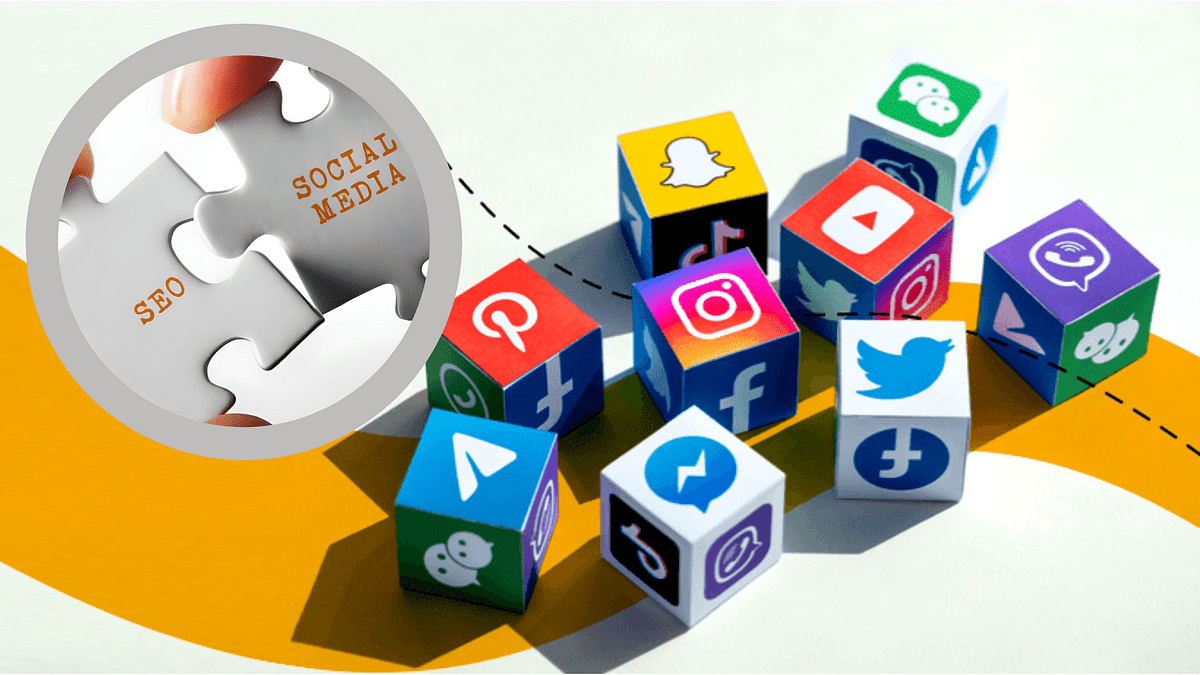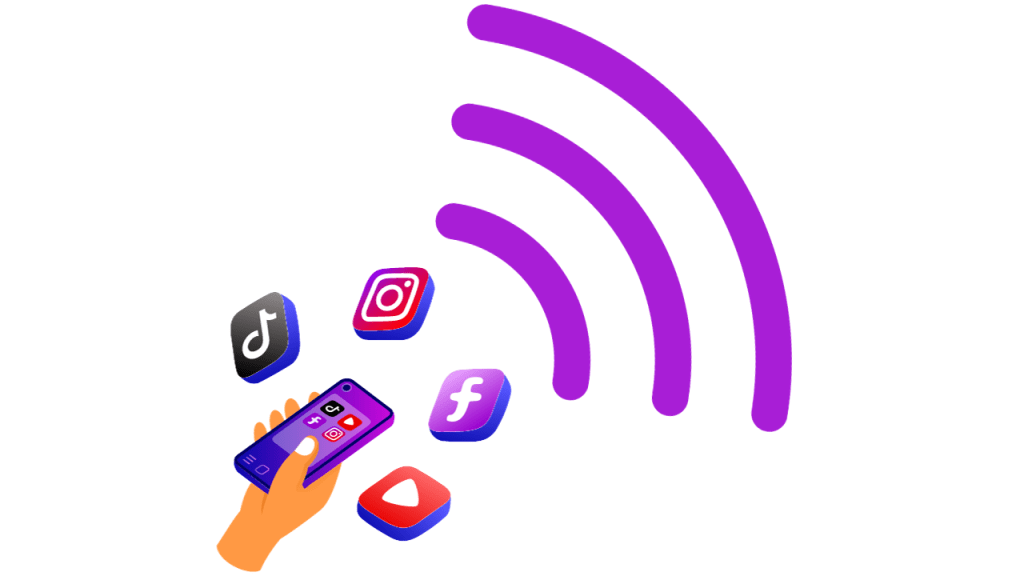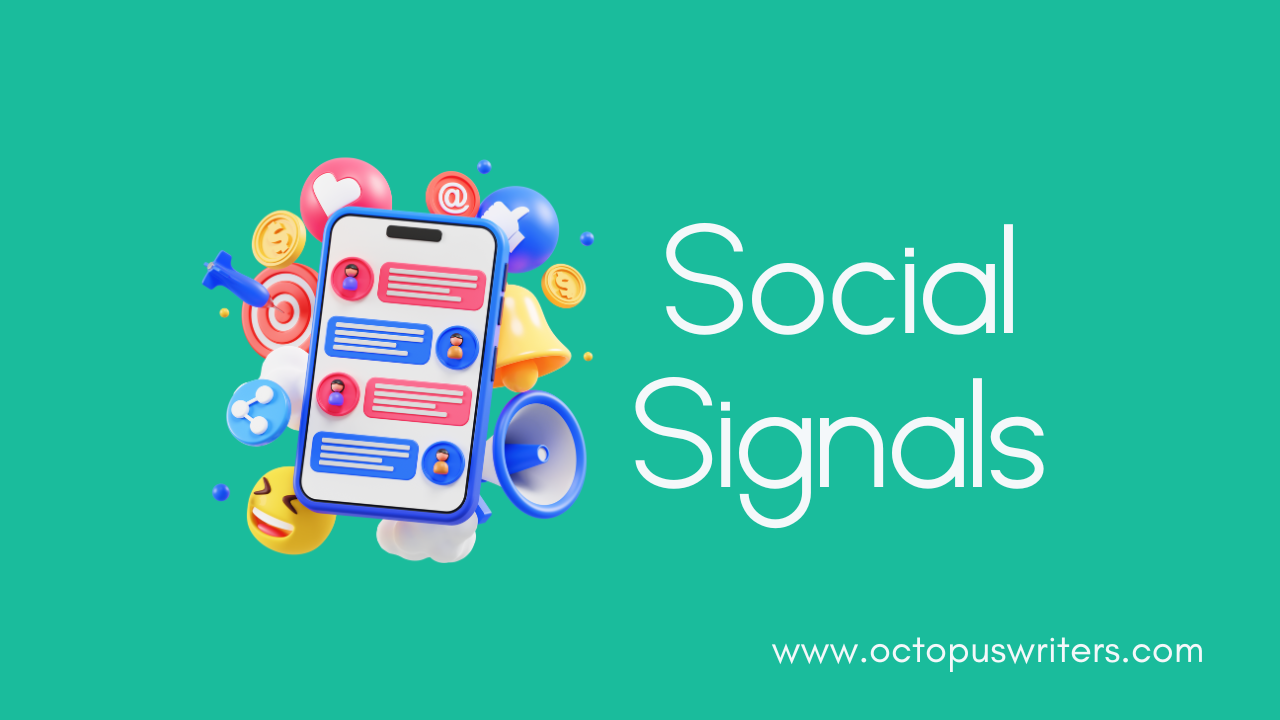While social signals may not serve as direct ranking factors in SEO, their influence cannot be overlooked. As engagement through likes, shares, and comments increases, it indirectly boosts SEO performance. OctopusWriters has seen how content that performs well on social media often drives more traffic, attracts valuable backlinks, and improves overall brand visibility, which are key elements in SEO success.
In the following article, we will break down the connection between social signals and SEO and offer strategies to make the most of this relationship. Let’s explore further with OctopusWriters through the insights shared below.
What Are Social Signals? Detailed Summary
Social media has become increasingly important over the years, both for personal use and business growth. A single share on a social platform can significantly boost website traffic, while likes and comments on posts offer a direct line of communication with (potential) customers. This engagement gives businesses insight into their brand image and helps them tailor content to user feedback. Social signals, such as shares and likes, reflect content quality but do they also affect search engine rankings?
Historically, social signals have had some impact. Relevant content may inspire bloggers or other sites to create backlinks, which can positively influence a website’s Google ranking. This suggests that social media interactions can have an indirect effect on SEO by driving traffic and influencing search engine evaluations.
Many marketers have recognized this connection and are actively using social media to boost SEO efforts. However, the relationship between social signals and SEO is still up for debate. Some studies claim that social signals have a direct effect on rankings, with sites that accumulate likes and shares often being seen as highly relevant by Google.
That said, it’s unclear whether these sites would have achieved similar rankings simply based on the strength of their content and backlink profile. In other words, social signals might just be a side effect of high-performing content rather than a direct ranking factor.

Google has stated that it is difficult to include social signals in its ranking algorithms, mainly due to the massive amount of data and the constantly shifting nature of user profiles on platforms like Facebook. The exception is Twitter, which has been integrated with Google for some time. Tweets are treated as content Google can analyze and use in its SEO evaluations.
In summary, while social signals do play a role in SEO, their exact influence is still not well-defined. However, they shouldn’t be dismissed they remain a valuable measure of a site’s reach and engagement.
What Are Social Signals Actually?
At OctopusWriters, we emphasize the importance of following essential social signals to measure the effectiveness of your marketing efforts. The main signals to focus on are:
- Likes
- Shares
- Views
- Comments
- Click-through rates (CTR)
- Number of followers
- Brand mentions
- Influencer engagement
By analyzing these metrics, businesses can gain valuable insights into audience interaction and optimize their campaigns for improved performance.
Understanding Social Signals In Marketing
Understanding how social signals impact search rankings and SEO is essential for effective social media marketing. At OctopusWriters, we recognize that social signals, like likes, shares, and overall visibility, are key engagement metrics that search engines use to evaluate a website’s content against competitors. These signals contribute to improving a page’s organic search performance.
Although Google has stated that social signals aren’t a direct ranking factor, search engines still analyze how frequently a URL is shared across the web to gauge its relevance and quality.
Whether you’re a small business or a large corporation, We emphasizes the importance of building a social media strategy that incorporates social signals. By understanding their role in marketing, you can enhance both your online presence and SEO results.
Now that we understand social signals, let’s explore their key types:
- Likes, shares, and comments: By consistently producing engaging content, businesses can increase likes, shares, and comments, boosting their social media presence. As these interactions grow, search engines recognize your relevance. Engaging with followers through responses and conversations helps build trust and brand visibility.
- Mentions and tags: Collaborating through brand mentions, backlinks, and tags can significantly widen your reach. OctopusWriters understands that Google considers backlinks as trust signals, which can positively influence search rankings.
- Reviews and ratings: Genuine customer reviews and ratings are crucial to establishing trust. Positive feedback signals that your brand is reliable, boosting your search rankings. Even with the best social media strategy, authentic reviews remain invaluable.
- Followers and subscribers: The number of social media followers and subscribers reflects audience interest. A growing following amplifies social signals and gives businesses insight into the effectiveness of their content strategies.
Why Is Social Signal Important?
Social signals are crucial in the world of SaaS and SEO for several reasons. First, they reflect the popularity and relevance of your content. High engagement on social media, such as likes, shares, and comments, signals that your content is resonating with your audience, driving greater brand awareness and online exposure.

While social signals themselves aren’t direct factors in search engine rankings, they can indirectly improve SEO. The increased traffic and visibility from social media can lead to more backlinks and enhanced user engagement, like longer time on site and more page views, all of which can positively impact organic search rankings.
Additionally, social signals help establish credibility and trust. Content that gains attention and shares across social platforms is often seen as reliable and valuable, helping to build your brand’s authority and reputation in the industry.
Benefits Of Tracking And Using Social Signals
Businesses that focus on social signals can unlock numerous advantages, including:
- Increased brand awareness and audience interaction: Social signals like shares, likes, and comments can significantly broaden your reach. The more your content is engaged with, the more visible it becomes to new potential customers, leading to higher engagement and brand recognition.
- Greater social proof and credibility: A strong presence on social media shows that your brand is well-regarded by others. Positive interactions and user engagement serve as social proof, boosting credibility and making your business more trustworthy in the eyes of potential clients.
- Improved understanding of audience preferences: Monitoring social signals gives valuable insights into which types of content your audience prefers. This data can help you fine-tune your marketing efforts to deliver content that better resonates with your target audience, increasing relevance and impact.
- Opportunities for organic promotion and user-driven marketing: High engagement often encourages customers to share their own content about your brand, from reviews to recommendations. This kind of user-generated content creates organic word-of-mouth marketing, increasing your brand’s reach and credibility without additional cost.
Challenges Of Relying On Social Signals
One of the risks associated with social signals is that some brands may turn to fake or spammy engagement tactics. Buying likes or followers might seem like an easy way to boost social proof, but it can ultimately damage a brand’s credibility and trustworthiness in the long run.
To avoid this, businesses should focus on cultivating real connections with their audience. By delivering valuable content and engaging authentically, companies can build a dedicated following that benefits from genuine social signals, leading to lasting success.
How Do Social Signals Impact SEO?
SEOs are still exploring the exact role that social signals play in SEO performance through ongoing studies and experiments. Although there is some debate within the field, we can reasonably conclude that social signals have an indirect impact on rankings by looking at how established ranking factors correspond with a website’s social media activity.

Social Media Profiles Can Rank
Google not only indexes social media profiles but also ranks them in search engine results. This means your business’s social media pages can be a key part of your visibility online, contributing to your overall digital presence.
Because Google aims to connect websites with their relevant social media profiles, the search engine likely looks for signals that link your website to those profiles. While these social profiles may not directly influence your rankings for target keywords, they are crucial for managing your SEO reputation. For instance, when you search for your business name, it’s common for your Facebook, LinkedIn, or Twitter page to appear on the first page of results.
On Twitter specifically, Google often displays the three most recent tweets directly in the search results (although likes and retweets aren’t shown). A strong social media presence in SERPs helps build trust with your audience, which can lead to more clicks on your site when users find it in organic search results.
More Social Shares Can Result In More Backlinks
Backlinks have always been a key factor in determining search engine rankings, playing a vital role in establishing a site’s authority. However, when someone shares a link to your web page on social media, such as through a tweet, it doesn’t pass link equity like a traditional backlink on a website would. Despite this, social shares still offer significant value by increasing your content’s visibility and driving more traffic to your site.
The more your content is shared and seen, the higher the chances are that users will find it valuable and choose to link back to it. At OctopusWriters, we emphasize that visibility is the first step in gaining backlinks, and social media is a powerful way to expand your audience. This is why social platforms should be considered an essential part of any effective link building strategy.
Quality Content Does Well On Both Social And Search
Picture a web page that has been shared thousands of times on social media, resulting in hundreds of thousands of likes, comments, and interactions.
When a web page generates that much social engagement, it’s a strong indicator that the content is valuable to users. It’s also common to see web pages with high search rankings displaying robust social media signals. However, this doesn’t mean Google uses social signals to determine rankings—correlation doesn’t mean causation.
Still, just as quality content performs well on social media, it also earns recognition from Google, whose algorithm values expertise, authority, and trust (EAT). By consistently creating high-quality content and promoting it on social media while optimizing for SEO, you can strengthen your presence across both channels.
Using Social Signals In Your SEO Strategy
Social signals still have a meaningful impact on your SEO and content marketing efforts. For certain searches, Google includes unique SERP features that highlight social media content. You might see a carousel showcasing recent posts from a person or brand, or a video section with content from platforms like YouTube, Facebook, and TikTok.
![]()
Consistently posting relevant material on social media can help your profiles appear in these features, driving organic traffic to your social pages and potentially your website. Even if traffic isn’t immediate, it significantly boosts your brand’s presence.
Social Signals Indicate Reach
Websites that rank highly on Google typically do so by combining relevant, high-quality content with a strong network of backlinks. These two factors are essential for achieving strong positions in search results, as Google prioritizes authority and relevance. However, another advantage successful websites often leverage is a large social media following.
Having thousands, or even millions, of followers on platforms like Facebook, Twitter, or Instagram can be a game changer. Every time followers engage with a post whether it’s liking, sharing, or commenting, it creates social signals that increase the website’s visibility. This engagement drives more traffic, often creating a snowball effect where increased exposure leads to more interaction and even more visitors.
While there’s still some debate over whether social signals directly impact Google rankings, their influence is undeniable. Some believe these signals work indirectly by encouraging backlinks from followers who find the content valuable. Others suggest that social signals, through high engagement, subtly influence rankings by highlighting the website’s popularity and relevance.
Regardless of whether social signals directly affect rankings, their impact on user behavior is what truly matters. When users see content that’s widely liked, shared, and commented on, it serves as social proof, showing that the content is valuable and worth attention. This can lead to higher click-through rates, longer time spent on the site, and ultimately more conversions or user actions.
In short, having a large social media following not only boosts immediate traffic but also helps build trust and credibility with both users and search engines. Social signals drive organic engagement, which increases website visibility and supports long-term SEO efforts.
How Can Social Signals Be Used?
Similar to real customer reviews in online shops, social signals can strongly influence others by building trust. The logic is simple: if a website has many fans, it must be credible after all, it wouldn’t be so popular otherwise. This sense of trust becomes even stronger when users see that their own friends have liked the page.
However, it’s essential not to overestimate this effect. Just because a site has 100,000 Facebook fans doesn’t mean that traffic will automatically surge. The content needs to be of high quality to sustain such a large following. Without consistent growth, 100,000 fans can quickly turn into inactive members who contribute neither traffic nor social signals. Many businesses that have attempted to “buy” fans have found little success with this approach.
On the flip side, when social signals are integrated into a meaningful marketing strategy, they can open up numerous possibilities. Engaging and relevant content can drive social signals, leading to an active and healthy social media presence. This can also be the foundation for building a newsletter or direct marketing strategy to supplement other sales channels.
Even without further actions, social signals alone can benefit a brand. They build trust, which is crucial for growing brand awareness. Moreover, engaged fans and followers can indirectly boost your website’s ranking by increasing traffic and generating backlinks on their blogs or websites.
16 Ways To Improve Your Social Signals For SEO
Link your website & social media profile pages
Google is actively working to connect websites with their social media profiles.
You can help facilitate this by linking your website to your social media pages and ensuring your social media profiles link back to your site. Though simple, this step is critical. In the past, SEOs relied on social media schema to make these connections, but Google has phased out support for this method.
Reciprocal linking now ensures Google can identify these connections on its own. Just be careful not to place social media links prominently on your homepage, where they might distract users from key CTAs or lead forms. A more effective placement for these links is in your footer.
This not only helps search engines but also improves navigation for your audience. Whether users discover your site or social media first, they’ll have an easier time finding all of your brand’s important links.
Optimize Your Social Profile Pages
Optimizing your social media profiles, just like you would a web page or blog post, can enhance their performance.
Adding target keywords to sections like “About Us,” “Products,” or “Services” can assist Google in recognizing your business’s connection to those keywords. It’s essential to fully complete every section of your profile, as Google crawls and interprets the content to understand what your brand is about.
The more detailed and optimized your profile is, the more chances you have to include key terms that relate to your business.
Claim Your Knowledge Panel
Google Knowledge Panels are a feature in search results that consolidate key brand information, such as social media profiles, into a single view for users. These panels typically appear for branded searches, like when someone looks up your company name. Google generates Knowledge Panels automatically, meaning you can’t apply for one if it hasn’t yet appeared for your brand.
However, if your business does have a Knowledge Panel, be sure to claim it. This gives you more control over how your information is displayed and lets you communicate directly with Google.
Promote Your Content Regularly Across Social Platforms
If you’re publishing content like blogs, articles, or ebooks on your website, you should also make it a priority to promote them regularly on your social media accounts.
The more you share your content on social media, the more opportunities you have to generate likes, shares, and engagement. Using tools like Sprout Social can streamline your posting by helping you plan and automate content for platforms like Twitter, Facebook, LinkedIn, and Instagram. If you haven’t hired a social media manager, now might be the time to consider one or outsource to an agency.
Here are some tips for consistently sharing your website content every day:
- Link to new content shortly after it’s published on your website.
- Reshare updated content when it provides better or more current information for users.
- Post relevant content from your site when industry news or trending topics align with what you’ve covered.
- When responding to user questions about specific topics, services, or products, provide a link to related content on your site that answers their inquiries.
These are just a few ideas for social media posts that include links back to your website. Although you can post without linking to your content, these posts won’t help your SEO. To gain indirect SEO benefits, make sure your posts contain links that lead back to your web pages.
Add Social Plugins To Make Your Content Easily Shareable
Visitors are much more likely to share your content if the process is quick and simple. Incorporating social sharing plugins into your content management system can streamline this process, making it easy for users to post your high-quality content directly to their social media accounts.

For example, Wordstream uses social media icons that follow users as they scroll through blog posts, encouraging easy sharing. When a user clicks to share, the post is already optimized, so they don’t need to spend extra time creating an engaging social post.
Make Your Content More Clickable With Twitter Cards And Open Graph Tags
We believe that making your content more clickable starts with using Twitter Cards and Open Graph tags.
These small pieces of metadata play a big role in how your web pages appear when shared on social media platforms like Facebook and Twitter. They ensure your content is presented with a catchy title, relevant description, and eye-catching image. When these tags are missing or incomplete, your content may look less attractive, resulting in fewer clicks.
By implementing Open Graph tags and Twitter Cards effectively, OctopusWriters ensures your social media posts are visually appealing and optimized for engagement. This not only increases traffic but also boosts your brand’s consistency across all platforms.
Actively Respond To Comments And Shares
To enhance your social signals, it’s essential to stay active on your social media profiles. Engaging with your audience by responding to comments and shares reassures users that a real person is running the account.
This active approach also provides more chances to share additional links to relevant pages on your website, encouraging more traffic and interaction. If you’re finding it difficult to stay on top of social media while managing other parts of your business, hiring a social media manager or outsourcing to an agency could be a smart move.
Share Other People’s Content And Foster Partnerships
Just as you’re working to increase your Facebook followers and boost engagement on Instagram, others in your industry are striving for the same. Sharing valuable content from other sources is a smart way to build connections and demonstrate that you’re an engaged participant in your professional community.
When you retweet content you find helpful or thank someone for sharing your posts, it opens the door to stronger relationships and more visibility. On Instagram, reposting content that resonates with you can lead to more engagement, such as additional likes or shares from those accounts.
By sharing content from others, you not only build relationships but also diversify your social media feed. This helps keep your audience engaged and shows you’re interested in delivering a well-rounded perspective, not just promoting your own content.
In the long run, these efforts can help you establish greater credibility, foster deeper relationships, and open up new opportunities for collaboration. Plus, the more you support others, the more likely it is that your own content will be shared, amplifying your reach and social signals.
Don’t Pay For Fake Followers Or Engagement
Social media engagement is crucial, but relying on fake followers or bot-driven interactions is not the answer. While it might seem tempting to boost your follower count quickly, fake engagement provides no lasting benefits and can harm your brand in the long run.
Social platforms are continually improving their ability to detect and remove bots. Even if these fake likes and follows give you a temporary boost, they won’t last. Once those artificial accounts are gone, you’re left with inflated numbers that don’t translate to real connections or conversions.
More importantly, fake followers won’t engage with your content in meaningful ways. Real users, on the other hand, interact, comment, and share, helping you build a loyal community. Authentic engagement fosters trust, something that fake numbers can never provide.
To grow your social presence sustainably, focus on organic engagement. Building a genuine audience may take longer, but it’s a far more valuable investment. Real followers engage with your brand, become advocates, and contribute to your long-term success.
By following our tips for organic growth, you’ll create a solid social media presence based on meaningful connections. Real engagement drives real results, don’t settle for short-term, fake fixes that ultimately damage your credibility.
Elevate The Social Media Reputation Of Your Creators
As noted previously, Google is paying more attention to the creators of website content. Additionally, search engines are now looking to social media to better gauge the authority of those content creators.
You can help elevate your authors by including bios in blog posts and articles. Linking to their social media accounts and tagging them when sharing their work can enhance their presence as experts. When Google sees that your content is produced by reputable creators, its Quality Raters are more likely to view your site as trustworthy and authoritative.
Implement Schema Markup
You can connect your social media profiles to your website and company by using schema markup. When applied correctly, schema markup can help your social profiles appear in the knowledge panel of SERPs, potentially boosting the visibility of your social content as well.
The sameAs schema property is the key to achieving this. It links your website with your social media profiles and helps search engines, like Google, understand that they are part of the same entity.

By utilizing the sameAs property, you’re essentially telling Google that the person or company behind the website is the same one managing the connected social media accounts. This helps Google establish a clear relationship between your website, your business, and your social profiles.
The simplest way to set this up is by using a plugin. If you’re on WordPress, you might want to try plugins like SchemaPro, Rank Math, or Yoast. These tools allow you to add the proper code with minimal effort. If you prefer to manually implement schema markup, you can do that as well. For detailed instructions, check out our guide to Organizational Schema, which explains how to use the sameAs attribute.
Ask For Engagement
Boosting social signals starts with asking your audience to share your content on social media. A well-placed and persuasive call to action (CTA) can go a long way in encouraging readers to engage and share.
For example, Trello’s blog uses CTAs that provide readers with pre-written social media posts. These posts, when shared, not only promote engagement but also link back to the original content, which helps build stronger social signals for your website.
Build A Strong Social Media Presence
Interact with your target audience on the social media platforms where they spend the most time to strengthen your social signals. While we’ve already discussed the benefits of using social media to promote and distribute content (broadcasting), its real potential lies in fostering conversation and engagement. Social signals are not just about sharing content, they’re about creating genuine interactions.
Beyond simply sharing your own content and asking others to do the same, you can actively engage with your audience by sparking discussions or even debates on relevant topics. These meaningful conversations not only increase your visibility but also improve your social signals by encouraging authentic interaction with your brand.
According to a 2022 Orbit Media study, social media users are nearly three times more likely to follow someone to “stay connected” than just to see the content they share. This shows the importance of building relationships over simply broadcasting content.
If your strategy is focused primarily on pushing messages out, consider shifting your approach. By pulling users into conversations, responding to comments, and fostering engagement, you’ll see stronger social signals and deeper connections with your audience over time.
Strong Correlation With Discover Traffic
Google Discover is a mobile feed that delivers highly personalized content based on your browsing habits. It showcases information on topics that interest you, whether it’s SEO, photography, or travel. Though many people don’t realize this feed exists on their devices, some businesses, especially content-driven websites, benefit significantly from Discover as a source of organic traffic.
Optimizing for Discover can be tricky, as it’s not entirely transparent how content is selected. However, one clear trend is that content generating high engagement through distribution tends to perform better. Google often promotes content that becomes popular on social media, pushing it to the top of the Discover feed. A strong presence on social media, backed by robust social signals, can enhance your performance on Google Discover.
An Indicator Of Becoming An Authority In Your Niche
One of the main ideas behind the flywheel model is to “Grow your authority to improve your rankings in search engines.” Although this simplifies things, authority is just one piece of the puzzle. It’s true that authoritativeness has become increasingly important in recent years.
Authoritativeness is one part of Google’s E E A T framework, which stands for expertise, experience, authoritativeness, and trustworthiness. Google relies on these criteria to adjust its search ranking system, and they all play a major role in evaluating website content.
Google’s Search Quality Evaluator Guidelines mention social media frequently, which suggests Google takes social media engagement into account when assessing a person’s or brand’s E E A T. Think about the experts you follow on social media, they likely demonstrate the E E A T qualities. That’s the level of credibility your brand should aim to build, not only on social platforms but across all channels.

By building strong social signals and showcasing expertise, your brand can become a trusted go to resource. We’ve seen this process unfold for ourselves in the SEO industry, where authority naturally compounds over time.
For example, Patrick, one of the top SEO authorities, shared a bold opinion that led to widespread discussion, which helped elevate engagement. We’ve noticed a similar pattern with backlinks, as engaging content often gets shared widely.
Of course, not all links are valuable. Some are from low quality sources like content aggregators or spam sites. But more often than not, we see our content featured in reputable industry news, demonstrating the power of being seen as an authority, as shown in one of our recent pieces.
Social Media Is A Part Of Your SEO And Content Marketing Flywheels
Rand Fishkin popularized the concept of the “marketing flywheel,” which describes a series of ongoing, repeatable marketing activities that build momentum over time. Each iteration requires less effort but produces more significant results, much like a snowball effect in marketing.
In the flywheel, content distribution plays a major role, and social media is central to that process. Strong social signals indicate that you’re gaining traction in this area. Without a strong focus on social media, the flywheel is bound to encounter much more resistance and lose its efficiency.
Examples Of How Social Signals Can Be Used As Part Of Social Media Marketing
Here are several examples of how social signals can be utilized to guide and optimize a business’s social media strategy:
- A clothing brand posts a new Facebook update to promote its latest collection. Hundreds of likes, shares, and comments pour in, signaling high engagement with their target audience. This indicates that the content is successful in capturing attention, encouraging the brand to consider sharing similar posts or content in the future.
- A travel blogger shares a photo on Instagram, asking followers to tag their favorite travel companions. The post attracts dozens of comments and tags, expanding the blogger’s reach. By observing this, the blogger is likely to create more interactive content to keep their audience engaged and learn more about their followers’ preferences.
- A software company uploads a YouTube video that showcases the features of its latest product. The video earns thousands of views and positive feedback, boosting the company’s industry visibility and social proof. OctopusWriters would recommend tracking these social signals to measure the interest around the product and fine-tune the video marketing strategy.
Social Signals And SEO: Best Practices
Create Shareable And Engaging Content
Let’s dive into how you can enhance your content to improve social signals:
- Develop content that’s easy to share: Creating content that resonates with your target audience is key to boosting social signals and supporting your SEO efforts. Focus on producing content that not only aligns with your brand but also grabs attention and motivates users to share it with their networks.
- Craft attention-grabbing headlines: A strong, compelling headline is crucial to making your content shareable. Ensure your headlines are designed to captivate readers and encourage sharing across social media platforms.
- Integrate multimedia for engagement: Incorporating visuals such as images, infographics, or videos can significantly boost the share ability of your content. Multimedia elements perform particularly well on social media, driving higher engagement and more shares.
- Provide real value: Content that offers valuable insights or addresses your audience’s needs is more likely to be shared. The more helpful and informative your content, the more it will contribute to stronger social signals and support your SEO goals.
Optimize Social Media Profiles
To improve your strategy, consider the following:
- Fully optimize your profiles: Your social media profiles are the first impression of your brand online. Make sure they are fully completed, accurate, and a true reflection of your brand. An incomplete or outdated profile may turn away potential followers and hurt your social signals.
- Include relevant keywords: Optimize your social media bios and descriptions by incorporating relevant keywords. This improves your visibility, making it easier for individuals interested in your industry to find and engage with your profiles.
Optimizing your social media profiles and using relevant keywords are essential steps to enhancing your visibility and credibility online. By making these adjustments, you’ll increase engagement and build stronger social signals, helping your brand grow across digital platforms.

Encourage And Facilitate Social Sharing
Boosting social sharing is essential for expanding your brand’s reach and driving engagement across social platforms. A well-executed strategy not only encourages your audience to share your content but also helps build a sense of community around your brand. By making it easy for visitors to share and staying engaged with them on social media, you can effectively increase the visibility of your content and strengthen your overall online presence.
- Incorporate social sharing buttons: Make sharing easy by adding social media buttons throughout your website. Whether it’s in your blog posts, product pages, or service offerings, these buttons allow visitors to quickly share your content with their own networks.
- Engage consistently on social media: Active engagement on social platforms is crucial to encouraging sharing. Participate in discussions, respond to comments, and interact with your audience regularly. By fostering meaningful connections, you increase the chances of your content being shared across various platforms.
By making sharing easy and staying actively engaged with your audience, you’ll not only increase your content’s reach but also foster a stronger online community, driving consistent social sharing and boosting your brand’s visibility.
Monitor And Analyze Social Signals
Here’s what you can do to enhance your strategy:
- Use advanced analytics tools: To better understand the effectiveness of your social signals and SEO efforts, employ advanced analytics tools that offer insights into your content’s performance on social media. Platforms like Google Analytics, social media-specific analytics, and SEO tools with social metrics provide the data you need to make informed decisions.
- Monitor key social signals: Pay attention to important social signals such as likes, shares, comments, and overall sentiment. By tracking these metrics, you’ll be able to assess your strategy’s impact, identify winning campaigns, and make data-driven adjustments to optimize future efforts.
Build Relationships For Backlink Opportunities
Here’s how you can improve your content for better social signals:
- Connect with influencers and thought leaders: Forming relationships within your niche is key to improving both social signals and your SEO strategy. Actively engage with influencers and thought leaders on social platforms by sharing their insights, contributing to discussions, and building authentic connections.
- Develop relationships for natural backlinks: As your relationships grow, there’s potential for organic backlinks. Influencers and thought leaders might link to your content, which will enhance your SEO profile. Strengthening these connections not only boosts your social signals but also creates more opportunities for valuable backlinks.
At OctopusWriters, we encourage focusing on building trust and credibility within your industry. Doing so will amplify your social signals, increase your visibility, and attract natural backlinks that elevate your overall SEO performance.
Build A Strong Social Media Presence
Maintaining active profiles on the right social media platforms is crucial for growing your brand. Make sure to regularly update your profiles with fresh, relevant content to keep your audience engaged. It’s not just about posting frequently; it’s about fostering real connections with your followers. Reply to comments, start conversations, and be an active participant in the community you are building around your brand.
Beyond just posting, consider the types of content that will resonate with your audience. Share valuable insights, behind the scenes content, or interactive elements like polls and Q&As. This variety helps maintain interest and encourages engagement, which ultimately strengthens your brand’s social presence. A well maintained social media presence also boosts your credibility and leads to stronger social signals that can enhance your SEO and overall digital strategy.
Analyze And Adapt
Using analytics tools is essential for tracking the effectiveness of your social media content. Monitor key metrics like comments, shares, likes, and overall engagement to understand what resonates with your audience. Once you identify the types of content that perform well, you can adjust your strategy to focus on what generates the most interaction.
Also, pay attention to the platforms you use and the timing of your posts. Certain content may thrive on one platform more than another or at specific times. Adapting your approach based on these factors will help you maximize reach and engagement.
By regularly reviewing your analytics and making adjustments, you can stay flexible and responsive to trends. This ensures your social media strategy remains relevant and effective in maintaining a strong connection with your audience.
Relation Between Social Signals And Ranking
Various studies have explored the relationship between a website’s ranking and its social signals. It’s often observed that top-ranking websites in search engine results tend to have a significantly higher number of social signals than others. However, no study has definitively proven that social signals directly influence rankings in a positive way. As such, the existence of a causal link remains unconfirmed.
Do Social Signals Directly Influence Rankings?
The myth Of Direct Causation
A common misconception in the world of SEO is the belief that social signals directly improve search engine rankings.
While it’s true that websites with high social engagement often rank well, the reality is that social signals alone do not function as direct ranking factors. Instead, the relationship between the two is more of a correlation than causation.
Google, the leading search engine, has repeatedly stated that metrics like likes, shares, and retweets are not factored directly into their ranking algorithms. Instead, Google’s focus is on a wide range of factors to assess a web page’s quality, relevance, and authority. Social signals, while valuable, are only one element in a much larger ranking system.
That said, social signals can indirectly impact your SEO efforts. High engagement can drive more traffic, increase visibility, and attract backlinks, all of which do contribute to better rankings. So, while social signals aren’t a direct ranking factor, they can still play a significant role in the overall success of your SEO strategy.

Correlation
Although social signals don’t directly influence search rankings, there’s a noticeable correlation between a strong social media presence and better SEO outcomes. This is largely due to the indirect effects social signals have on search engine factors.
- Enhancing user engagement and dwell time: Socially popular content often drives more clicks and longer visits to a website.
Google uses these engagement metrics as signals of content relevance and quality, which can indirectly influence rankings. - Establishing trust through social signals: Content with a high number of shares on social media is typically viewed as more credible and authoritative.
Since search engines aim to provide trustworthy results, content that is socially validated may gain an indirect advantage. - Expanding content visibility: Social signals help spread your content to a wider audience, leading to more opportunities for organic backlinks.
Increased backlinks and broader visibility can enhance your site’s SEO, improving overall rankings.
AI And Social Signals
As search engine algorithms evolve, artificial intelligence (AI) is playing a crucial role in analyzing and interpreting social signals more effectively.
AI-driven systems can evaluate user interactions on social media platforms, giving search engines deeper insights into how audiences engage with content. Whether it’s likes, shares, or comments, these interactions allow AI to assess which content is relevant and meets user expectations.
Although social signals don’t directly influence search rankings, the information AI extracts from them helps search engines better understand user intent and content quality. This contributes to more accurate search results, offering users the content they’re looking for. Moving forward, AI’s role in refining how social signals are processed will become essential for search engine optimization.
Tracking Social Signals: Tools And Techniques
Monitoring and evaluating social signals is vital for fine-tuning both your social media and SEO strategies. Below are a range of effective tools and techniques to help you track how your content performs across various social media platforms:
Google Analytics
Google Analytics is a powerful tool for gaining insights into your social signals and how they align with your SEO strategy. The Social Reports feature offers important metrics like:
- Social Interactions: Track user engagement through likes, shares, and comments to see how your content is resonating.
- Conversions: Understand the role of social media in driving conversions, helping you assess the success of your content.
- Comprehensive impact: Get a full picture of how social media traffic influences your website’s overall performance and growth.
Social Media Analytics Tools
For effective social signals analysis, make use of the analytics tools provided by popular social media platforms:
- Facebook Insights: Get detailed insights into your page’s performance, including metrics on engagement, audience demographics, and post reach.
- Twitter Analytics: Review tweet performance, engagement levels, and follower demographics to refine your Twitter approach.
- Instagram Insights: Track key metrics like reach, engagement, and impressions to better understand how your Instagram content is performing and where improvements can be made.
Using these platform-specific analytics tools helps you tailor your strategy based on performance data, improving your content’s reach and impact while boosting your overall social media presence
Custom UTM Parameters
Using custom UTM (Urchin Tracking Module) parameters in your social media links is a smart way to track and measure the effectiveness of your social media efforts.By customizing your URLs with UTM parameters, you can:
- Pinpoint Traffic Sources: Accurately determine which social media channels are bringing traffic to your website.
- Evaluate Campaign Performance: Measure the success of specific campaigns and promotions across different social media platforms.
UTM parameters also offer valuable insight into the user journey, helping you understand which social interactions lead to conversions or other key actions. This data gives you the ability to adjust your social media strategy based on what works best.
Implementing UTM tracking into your social links enables you to better optimize your campaigns and focus on driving measurable results from your social media activities.

Sentiment Analysis tools
Analyzing the sentiment and engagement levels of your social media content is key to optimizing your social signals and improving your SEO strategy. Sentiment analysis tools can help you:
- Understand Overall Sentiment: Assess whether the conversations around your content are positive, negative, or neutral. This gives you a clearer view of how your audience feels about your brand and helps guide your messaging moving forward.
- Track Engagement Levels: Examine how users are engaging with your posts, whether through comments, shares, or likes. By understanding the volume and quality of engagement, you can determine if your content is meeting your marketing objectives.
In addition, tracking sentiment alongside engagement helps you identify trends and adjust your strategy accordingly. Positive feedback may indicate successful content, while negative sentiment offers opportunities for improvement and engagement recovery.
Frequently Asked Questions About Social Signals
How Do You Track Social Signals?
There are several tools available to help you track social signals effectively.
- Google Analytics allows you to see how much traffic your website is receiving from various social media platforms.
- Semrush Social is an all-in-one solution for monitoring social signals, providing detailed insights into engagement, audience growth, and the success of specific posts.
Do Paid Social Media Campaigns Boost Social Signals?
Yes, broadening your content’s audience can lead to greater engagement, increased shares, and ultimately more visits to your site.
Will More Social Signals Help My Content Rank Higher In Google?
No, Google has confirmed multiple times that social signals, such as likes and shares, do not act as direct ranking factors. Simply increasing social signals will not enhance your page’s organic search position.
Do Social Signals Contribute To A Website’s Domain Authority?
While not a direct factor, social signals can influence a site’s domain authority indirectly. Strong engagement on social platforms can attract backlinks, as more people view and link to the content.
How Social Signals Affect SEO In 2024

In 2024, social signals still don’t function as direct ranking factors in SEO, but their influence shouldn’t be overlooked. When content gains significant traction on social media, it can lead to greater exposure and potential backlinks, which are critical for boosting a site’s authority. Social signals also improve brand awareness and generate more traffic to your site, indirectly supporting stronger SEO performance.
Conclusion
To sum up, OctopusWriters highlights the indirect but important role social signals play in boosting SEO performance. When your content receives attention in the form of likes, comments, and shares, it drives traffic to your website, improving key SEO metrics such as dwell time and click-through rates. These metrics, in turn, signal content quality to search engines.
Additionally, strong social signals often lead to natural backlinks, a core component in increasing website authority. The more your content is shared and discussed, the higher the chances of it being linked by other reputable sites, further enhancing SEO. OctopusWriters sees this as a key opportunity for long-term growth.
Ultimately, we believe that integrating social signals into your digital strategy allows you to reach a broader audience, build credibility, and strengthen your presence in search rankings. It’s a smart, long-term investment that drives sustainable growth for your brand online.

